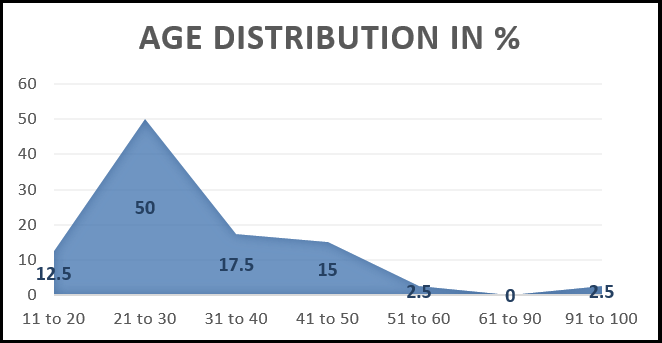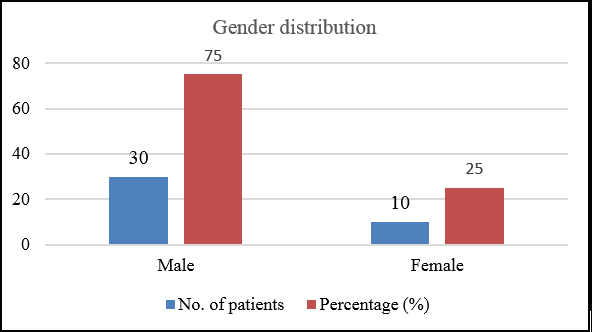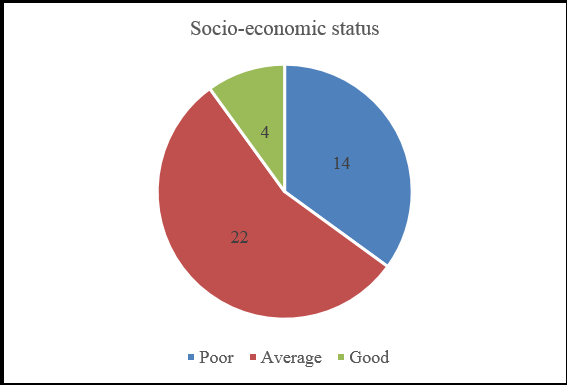- Visibility 81 Views
- Downloads 21 Downloads
- DOI 10.18231/j.ijfmts.2020.024
-
CrossMark
- Citation
Why men being the victim of suicidal hanging? – A prospective study
- Author Details:
-
Esther Vinita Vijaykumar *
-
Annamallai M
-
Sampath Kumar
Introduction
Death is inevitable to everyone once life starts. But premature ending of one’s own life has seen an alarming rise in the recent years. According to WHO[1] approximately one million people die from suicide, and 10 to 20 times more people attempt suicide worldwide every year. All over the world, suicide is now one of the three leading causes of death among people aged 15-34 years. In India, according to the National Crime Record Bureau (NCRB), 1.3 lakh people committed suicide every year. About 4 lakh people attempted suicide, and 15 suicides took place every 1 hour. There is always been a raise every year. Overall male victims are encountered more commonly in suicide. [2]
We say men are strong in nature, by the creation of God, but it’s strongly proved only by physic, mentally they are weaker than women. Women have the nature of letting out their emotions, while the men don’t react much. They keep themselves strong outside suppressing all their emotional thrush inside them. They may break down by anger but not by tears. So when they keep everything inside their mind, many question run inside their mind, where they try to find solution. Men always manage all their problems alone without asking for anyone help. In case of married men responsibility and burden double’s where they take hold of the family. Where men from ancient is being called the head of the family, where he has to take care of everything in his family. Even if we talk about sex equality, men are being the major share holder of all the problems to take care off. So this masculine man sees to it that his responsibility to his family goes without any flaws. Their only strength is their family, but when their family revert towards them, many men end up taking a strange decision of taking up their lives. Preferring hanging as a choice of suicide.
Hanging is a form of ligature strangulation that involves suspension by the neck. Hanging can be classified as either complete or incomplete. When the whole body hangs off the ground and entire weight of the victim is suspended at the neck, the hanging is said to be complete hanging. Incomplete hanging implies that some part of the body is touching the ground and that the weight of the victim is not fully supported by the neck. [3]
Material and Methods
Study design
Longitudinal prospective observational study.
Study setting
Cases of hanging brought to the mortuary of Sri Ramachandra Medical College and Research Institute, Chennai for post-mortem examination.
Period of study
January 2012 to September 2013,
Study population
Eligibility criteria
Inclusion criteria
All the victims or patients , who died due to hanging , brought to Sri Ramachandra Medical College and Research Institute, Chennai for medico legal autopsy will be included
Cases belonging to both sex
Both the cases treated / untreated
Exclusion criteria
Cases other than hanging
Decomposed bodies where the finding will be obliterated
In each case, detailed history was collected both from the police and the relatives. In case of hospital deaths, case sheets were perused. Thorough examination of clothes and alleged ligature materials, if produced were done before autopsy. Detailed external and internal examination of dead body was conducted by the bloodless neck dissection technique.
Results and Discussion
The maximum number of death due to hanging in the study was seen in the age group between 21-30 years (50%). Least number of cases was seen in 51- 60 years (2.5%).


Of the 40 cases of hanging encountered, males accounted for 30 cases (75%) as compared to 10 cases (25%) in females, indicating a male: female ratio of 3:1in the study.
It was observed that married victims were more 60% as compare to unmarried victims 40%. Males 75% were comparatively higher than females 25%.
As discussed in the above two criteria, the most common age group affected in this study was between 21-30 years. The observation of this study was similar to the study done by Charoonsak Nualchaem[4] in which the common age groups of the victims were the same. Large numbers of cases were males, with a male: female ratio of 3:1. This increase in number of male victims is mainly because of the stress and burden they face every day. Female deaths were seen in less number of cases, where predominant age group of females were between 11-20 years, and the incidence was found decreasing with advancing age (> 30 years) probably because, females could withstand pressures of life as age advances, by virtue of the social structure of the communities. Similar findings were observed by Charoonsak Nualchaem,[4] where 65.7% were male victims who ended their lives by hanging. It is in contrast to the finding observed by Ahmad M and Hossain MZ[5] in which females were more (85 %) when compared to males (41.37%).
|
Habits |
No. of victims |
(%) |
|
Smoking |
2 |
5 |
|
Alcoholism |
4 |
10 |
|
Both smoking and alcoholism |
14 |
35 |
|
Drugs |
2 |
5 |
|
None |
18 |
45 |
The habit of each individual was collected from history. Almost 18 cases (45%) did not give any history of drug / alcohol abuse, where 14 cases (35%) had history of both smoking and alcohol, only alcohol in 4 cases (10%) and only smoking in 2 cases (5%). History of some form of drug abuse was found to be with 2 cases (5%).
The socio-economic status of the victims of the study in which 22 victims (55%) fall in average group whereas 14 (35%) were poor and 4 (10%) belonged to good socio-economic status.

In the present study, antecedent factors were sought from each case. It was noted that quarrel claimed 12 lives (30%), economical problems accounted for 9 deaths (22.5%) and chronic physical pain or illness accounted for 7 deaths (17.5%). Other motives behind hanging were marital disharmony (12.5%), depression (5.0%) and dowry torture (2.5%), failure of love affairs, some form of prolonged harassment (2.5%) and in 2 cases (5%) motive were not known.
In the present study population, 23 cases (57.5%) were found spot dead. Treatment was taken by 2 (5.0%) of the victims after fatal attempt prior to death; whereas 15 (37.5%) of the people had not received any treatment because it was on the way
|
Place |
No. of victims |
(%) |
|
On spot |
23 |
57.5 |
|
On the way |
15 |
37.5 |
|
Hospital |
2 |
5 |
|
Material |
No. of victims |
(%) |
|
Soft and broad |
31 |
77.5 |
|
Thin and tough |
5 |
12.5 |
|
Rough and tough |
4 |
10 |
Ligature material was produced with the body or present in situ on the body in few cases i.e. 18 (45%) and in rest the type of ligature material used to commit hanging was known from the ligature material produced later by police or from the history collected from police, family members or neighbours etc. Out of the 22 (55%) cases where ligature material was not produced in 8 cases it was burnt by the relatives before handing over the body to police. This illegal act is being practiced by some communities of Tamil Nadu as a routine ritual after death where all belongings are immediately burnt after death. It was observed that the nature of ligature material was soft and broad type in 31cases (77.5%), thin and tough in 5(12.5%) and rough and tough in 4(12.5%) cases.
As discussed, The Ligature materials used were easily available ones which includes soft materials such as Sarees, lungis and chunnis (77.5%). Sharija S et al[6] in their study, have observed that soft ligature materials are preferred in majority of the cases. David G et al[7] in their study observed that the most commonly used ligature material were rope, belts, flexes.
Conclusion
As hanging is a common man preference for committing suicide among the middle age group both male and female, with an easily available material accessible to use in a close atmosphere mainly in family surrounding. Marital failure where they lose hope in their family plays a major role in many of the cases. This study highlight the importance of once mentality, where male gender are being highly encounter for ending up their lives due to stress in their family life. Gender is not a criterion for depression.
Source of Funding
None.
Conflict of interest
None.
References
- . World Health Organization. Figures and facts about suicide. WHO. 1999. [Google Scholar]
- . Accidental deaths and suicides In India, 2012, National Crime Records Bureau. Ministry of Home Affairs Government of India. 2013. [Google Scholar]
- B R Sharma, D Harish, V P Singh, P Singh. Ligature mark on neck: How information. J Ind Acad Forensic Med 2005. [Google Scholar]
- C Nualchaem. Postmortem findings from suicide hanging dead bodies. Vajira Med J 2009. [Google Scholar]
- M Ahmad, M Z Hossain. Hanging as a method of suicide: retrospective analysis of post-mortem cases. JAFMC Bangladesh 2010. [Google Scholar]
- S Sharija, K Sreekumari, O Geetha. Epidemiological Profile of Suicide by Hanging in Southern Parts of Kerala: An Autopsy based Study. J Ind Acad Forensic Med 2011. [Google Scholar]
- D Gunnell, O Bennewith, K Hawton, S Simkin, N Kapur. The epidemiology and prevention of suicide by hanging: a systematic review. Int J Epidemiol 2005. [Google Scholar]
How to Cite This Article
Vancouver
Vijaykumar EV, M A, Kumar S. Why men being the victim of suicidal hanging? – A prospective study [Internet]. IP Int J Forensic Med Toxicol Sci. 2020 [cited 2025 Sep 13];5(3):103-106. Available from: https://doi.org/10.18231/j.ijfmts.2020.024
APA
Vijaykumar, E. V., M, A., Kumar, S. (2020). Why men being the victim of suicidal hanging? – A prospective study. IP Int J Forensic Med Toxicol Sci, 5(3), 103-106. https://doi.org/10.18231/j.ijfmts.2020.024
MLA
Vijaykumar, Esther Vinita, M, Annamallai, Kumar, Sampath. "Why men being the victim of suicidal hanging? – A prospective study." IP Int J Forensic Med Toxicol Sci, vol. 5, no. 3, 2020, pp. 103-106. https://doi.org/10.18231/j.ijfmts.2020.024
Chicago
Vijaykumar, E. V., M, A., Kumar, S.. "Why men being the victim of suicidal hanging? – A prospective study." IP Int J Forensic Med Toxicol Sci 5, no. 3 (2020): 103-106. https://doi.org/10.18231/j.ijfmts.2020.024
